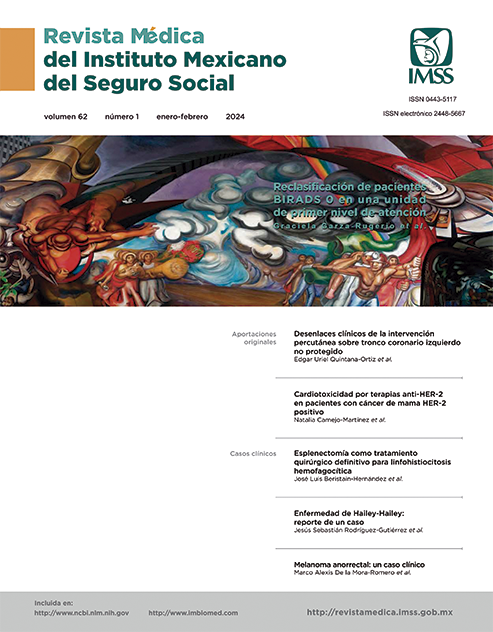Splenectomy as definitive surgical treatment for hemophagocytic lymphohistiocytosis
Main Article Content
Keywords
Lymphohistiocytosis, Hemophagocytosis, Hyperferritinemia, Pancytopenia, Splenectomy, Hemophagocytic
Abstract
Background: Hemophagocytic syndrome or hemophagocytic lymphohistiocytosis (HL) is an immune hyperactivation of multifactorial etiology, characterized by excessive activation of lymphocytes and macrophages, as well as numerous pro-inflammatory cytokines. It has a non-specific and highly variable clinical presentation, with splenomegaly being one of the clinical manifestations. Due to its nature, it can manifest during childhood or adult life, which is why it is a disease of diagnostic and therapeutic complexity.
Clinical case: 38-year-old male patient without comorbidities, who presented with abdominal pain, choluria, fever > 38 °C and diaphoresis of more than 10 days of evolution. A bone marrow aspirate was performed as part of the diagnostic approach with data compatible with hemophagocytosis and cytopenias. The immunosuppressive management did not show the expected response, which is why an open splenectomy was performed as the last therapeutic option with adequate hematological control. A documentary review of the disease was carried out, and of the therapeutic options, emphasizing surgical management in case of refractoriness to medical treatment.
Conclusions: Splenectomy increases the overall survival rate and the time free of HL progression, even though there are still no studies to determine with certainty the ideal time to perform a splenectomy in patients with pancytopenia without splenomegaly who suffer from hemophagocytic syndrome.
References
Astudillo P, Parejas C, Wietstruck MA, et al. Síndrome hemofagocítico: Caracterización clínica y seguimiento de una cohorte pediátrica chilena. Revista Chilena de Infectología. 2021;38(3):423-31. doi: 10.4067/S0716-10182021000300423.
Yao S, Wang Y, Sun Y, et al. Epidemiological investigation of hemophagocytic lymphohistiocytosis in China. Orphanet J Rare Dis. 2021;16(342):1-9. doi: 10.1186/s13023-021-01976-1.
Valdés Díaz KC, Hernández Negrín H, Valdés Leiva L, et al. Linfohistiocitosis hemofagocítica, un síndrome potencialmente fatal. Presentación de tres casos. Revista Cubana de Hematología, Inmunología y Hemoterapia. 2020. Disponible en: http://scielo.sld.cu/scielo.php?script=sci_arttext&pid=S0864-02892020000100010.
Salunke B, Savarkar S, Patil VP. Hemophagocytic Syndrome-An Approach to the Management. Indian J Crit Care Med. 2019;23(3):S191-6. doi: 10.5005/jp-journals-10071-23251.
Astigarraga I, Gonzalez-Granado LI, Allende LM, et al. Síndromes hemofagocíticos: la importancia del diagnóstico y tratamiento precoces. An Pediatr (Barc). 2018;89(2):124.e1-124.e8. doi: 10.1016/j.anpedi.2018.05.003.
Galán Gómez V, Pérez Martínez A. Síndrome hemofagocítico. Pediatr Integral. 2021;25(6):326.e1-326.e9.
Konkol S, Rai M. Lymphohistiocytosis. Treasure Island (FL): StatPearls: 2021. Disponible en: https://www.ncbi.nlm.nih.gov/books/NBK557776/
Knaak C, Schuster F, Nyvlt P, et al. Treatment and Mortality of Hemophagocytic Lymphohistiocytosis in Adult Critically Ill Patients: A Systematic Review With Pooled Analysis. Critical Care Medicine. 2020;48(11):e1137-46. doi: 10.1097/CCM.0000000000004581.
Cruz-Hernández V, Díaz-Albarrán R, Sosa-López R, et al. Síndrome hemofagocítico reactivo en el adulto. Avan C Salud Med. 2021;8(21):8-1.
Uribe-Franco RC, Milán-Salvatierra AI, Román-Bahena DA. Síndrome hemofagocítico secundario. Rev Hematol Mex. 2021;22(3):189-96. doi: 10.24245/rev_hematol.v22i3.5529.
Benigno Rodrigues J, Pinto Nasr B, Dos Santos Cypriano M. Hemophagocytic lymphohistiocytosis: presentation and outcome of twenty-one patients at a single institution. Hematol Transfus Cell Ther. 2022;44(4):485-90. doi: 10.1016/j.htct.2021.05.003.
Marie M, Yenan B. Genetics and pathophysiology of haemophagocytic lymphohistiocytosis. Acta Pediatrica. 2021;110(11):2903-11. doi: 10.1111/apa.16013.
Yu RK, Dae YK. Current status of the diagnosis and treatment of hemophagocytic lymphohistiocytosis in adults. Blood Research. 2021;56 (1):17-25. doi: 10.5045/br.2021.2020323.
Ponnatt TS, Lilley CM, Mirza KM. Hemophagocytic Lymphohistiocytosis. Arch Pathol Lab Med. 2022;146(4):507-519. doi: 10.5858/arpa.2020-0802-RA.
La Rosée P, Horne A, Hines M, et al. Recommendations for the management of hemophagocytic lymphohistiocytosis in adults. Blood. 2019;133(23):2465-77. doi: 10.1182/blood.2018894618.
Risma KA, Marsh RA. Hemophagocytic Lymphohistiocytosis: Clinical Presentations and Diagnosis. J Allergy Clin Immunol Pract. 2019;7(3):824-32. doi: 10.1016/j.jaip.2018.11.050.
Lavalle J, Minissale C, Carnelutto N et al. Manifestaciones clínicas, factores pronósticos y respuesta terapéutica del síndrome hemofagocítico: experiencia del HCJSM. Hematologia. 2020;24(1):21-31.
Dávila Dupont D, De la Peña López IR. Síndrome hemofagocítico Reporte de un caso y revisión de la literatura. Rev Fac Med UNAM. 2019;62(2):15-21. doi: 10.22201.fm.24484865e.2019.62.2.04.
Guillemette F, Claire L, Benjamin C, et al. Splenectomy for haemophagocytic lymphohistiocytosis of unknown origin: risks and benefits in 21 patients. Br J Haematol. 2021;3(194):635-50.
Ma J, Jiang Z, Ding T, et al. Splenectomy as a diagnostic method in lymphoma-associated hemophagocytic lymphohistiocytosis of unknown origin. Blood Cancer J. 2017;7(2):1-3. doi: 10.1038/bcj.2016.125.
Jing-Shi W, Yi-Ni W, Lin W, et al. Splenectomy as a treatment for adults with relapsed hemophagocytic lymphohistiocytosis of unknown cause. Ann Hematol. 2015;94 (5):753-60. doi: 10.1007/s00277-014-2276-9.


